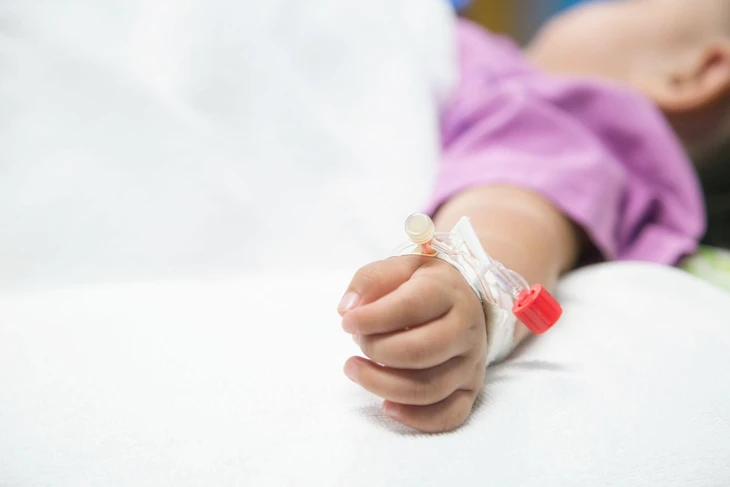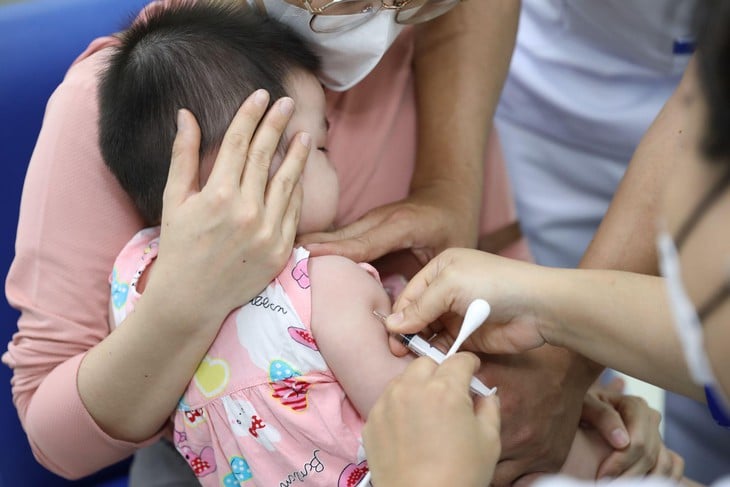Experts say meningococcal disease is transmitted through the respiratory tract or indirect contact, sharing contaminated objects. All ages are at risk of contracting the disease.
Continuously recorded cases
In just over the first 2 months of 2025, hospitals across the country continuously recorded severe cases of meningococcal disease, including deaths.
Of which, the 108 Military Central Hospital ( Hanoi ) received a 24-year-old soldier who died of circulatory arrest and fulminant meningococcal septic shock. Bach Mai Hospital (Hanoi) treated a 17-year-old unvaccinated teenager with critical meningococcal disease, complications of myocarditis and cerebral infarction. 74 close contacts are being monitored for their health status.
Previously, a 7-year-old patient in Co Linh commune, Pac Nam district, Bac Kan fell into a coma and had circulatory arrest due to meningococcus just a few hours after being admitted to the hospital.
According to experts, children under 5 years old, especially children under 1 year old, are at the highest risk of contracting meningococcal disease due to their weak and incomplete immune systems.
Children often have the habit of crawling on the floor, putting their hands or objects in their mouths, and living in playgrounds and kindergartens with many other children, so they are at increased risk of getting sick.
According to the Department of Disease Prevention ( Ministry of Health ), the number of people carrying meningococcal bacteria without symptoms is from 5-25%.
This is a source of infection that is difficult to control and is especially dangerous for children when adults or older children in the family carry the virus and kiss, hug, or talk closely with the child.
Meningococcal disease can cause death within 24 hours with many serious complications such as: meningitis, sepsis, pneumonia, arthritis, otitis media, pericarditis...
Early symptoms of meningococcal disease resemble those of the flu and are a challenge to diagnose early. Up to 20% of survivors face many sequelae such as amputation, deafness, epilepsy, mental retardation, etc.
Notably, hearing loss is more common in infants and toddlers under 2 years of age than in older children. Consequences such as musculoskeletal disorders, learning disabilities, and kidney failure can appear years or even decades after the onset of the disease.
In addition to the severe sequelae, meningococcal disease also causes billions of dollars in treatment and recovery costs. The disease also brings mental and psychological burdens to families and caregivers, such as post-traumatic stress disorder and mental disorders.
Need to proactively prevent disease
Experts recommend proactive disease prevention for children and family members as a way to prevent meningococcal disease.
The common meningococcal serogroups A, B, C, W, Y have vaccines in Vietnam including the American A, C, Y, W-135, Italian B, and Cuban B, C vaccines. It is necessary to fully prevent all 5 meningococcal bacteria groups A, B, C, Y, W-135.
A US study on mortality rates by meningococcal serogroup reported from 2017 to 2021 found that group W had the highest mortality rate, accounting for 21.5%, followed by groups C, Y and B with 14.6%, 9.8% and 9.6%, respectively.
Since its introduction, the quadrivalent conjugate vaccine A, C, Y, W-135 has reduced the number of cases of disease in adolescents caused by the major serogroups C, Y, and W by up to 90%.
In addition, the family applies other disease prevention measures such as avoiding contact with people showing signs of respiratory infections.
Parents should make their children wear masks when going to crowded places, instruct them to wash their hands properly with soap, wear masks when going to crowded places, cover their mouth and nose when coughing or sneezing...
Read moreBack to Topic Page
PN
Source: https://tuoitre.vn/ngua-benh-tu-24-gio-do-nhiem-nao-mo-cau-o-tre-nho-2025042219431279.htm
























































![[Maritime News] More than 80% of global container shipping capacity is in the hands of MSC and major shipping alliances](https://vphoto.vietnam.vn/thumb/402x226/vietnam/resource/IMAGE/2025/7/16/6b4d586c984b4cbf8c5680352b9eaeb0)













































Comment (0)